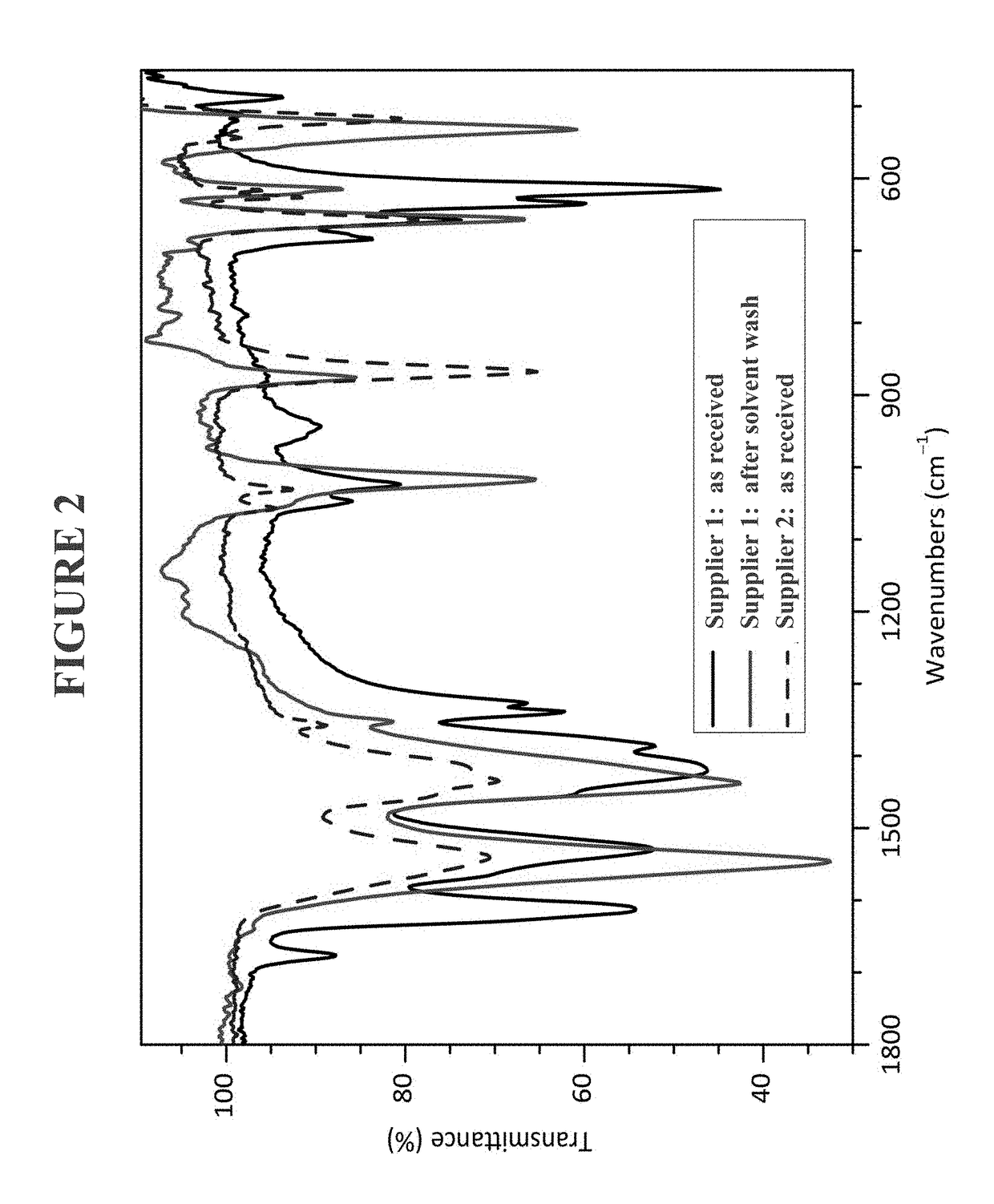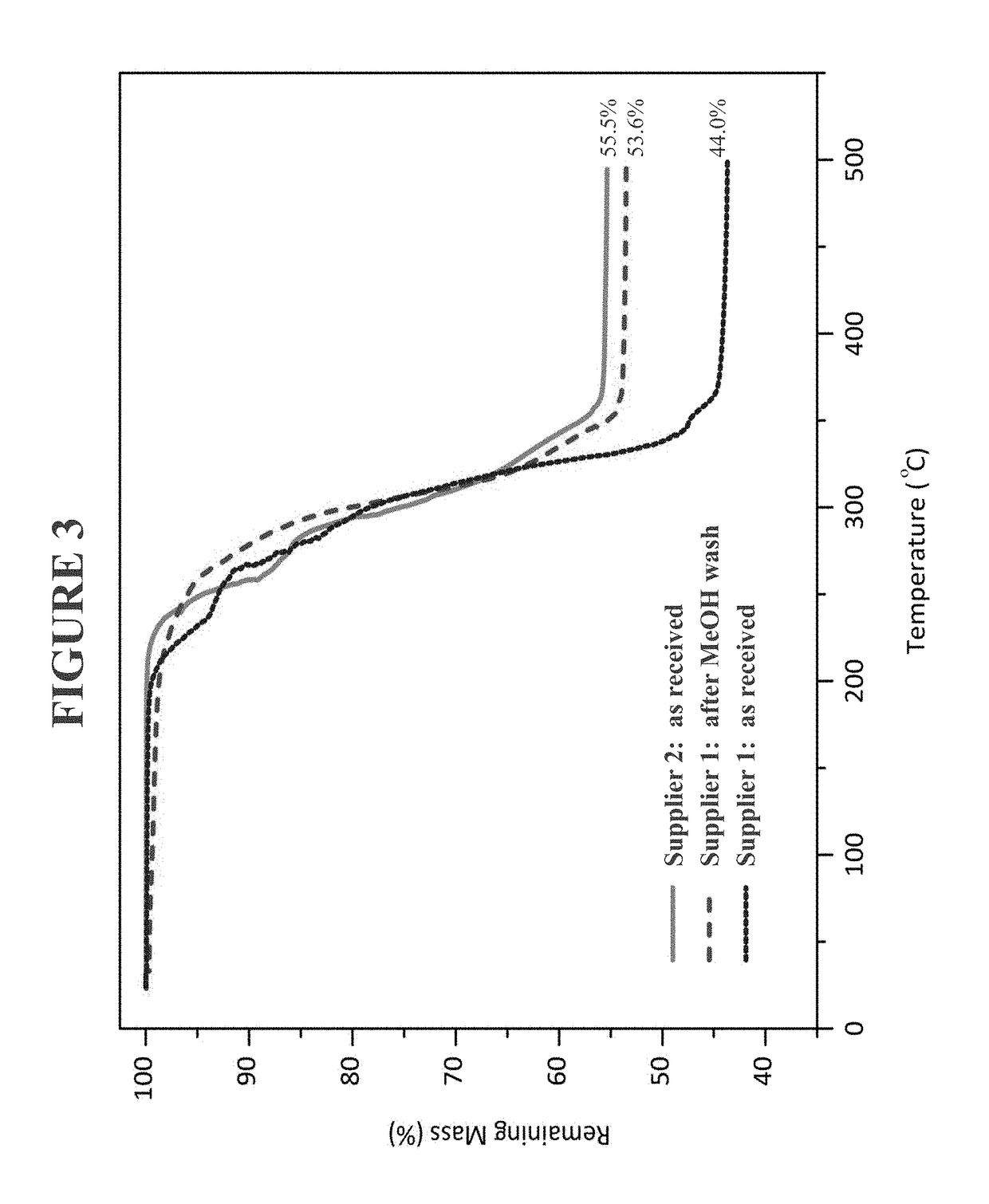Use of heteroleptic indium hydroxides as precursors for INP nanocrystals
a technology of heteroleptic indium hydroxide and nanocrystals, applied in the field of nanostructure synthesis, can solve the problems of increasing production costs, affecting the ability of the one in the art to know and control, and the synthetic method will not produce consistent nanocrystal products
- Summary
- Abstract
- Description
- Claims
- Application Information
AI Technical Summary
Benefits of technology
Problems solved by technology
Method used
Image
Examples
example 5
of a Red Core Nanostructure with 0.125 Additional Equivalents of Lauric Acid Added
[0268]A 100 mL round-bottomed flask was dried in an oven followed by evacuation under dynamic vacuum. Under nitrogen, 5.35 g (21.41 mmol, 1.00 equivalent) of indium acetate hydroxide, 8.93 g (23.08 mmol, 1.08 equivalents) trioctylphosphine oxide (TOPO), and 8.6 g (42.93 mmol, 2.00 equivalents) of lauric acid were added to the flask. The flask was heated to 125° C. with nitrogen at 20 L / min (with venting using a bubbler) and stirred at 1200 rpm overnight. The next day, the flask was placed under dynamic vacuum for 40 minutes. The flask was then placed under nitrogen and an additional 0.535 g (2.67 mmol, 0.13 equivalents) of lauric acid was added. The flask was heated to 320° C. at which time active heating was stopped and a solution containing both 1.5 grams (14.40 mmol, 0.67 equivalents) tris(trimethylsilyl)phosphine and 6 g (16.19 mmol, 0.76 equivalents) of trioctylphosphine was added. Stirring was in...
example 6
of a Green Core Nanostructure with No Additional Equivalents of Lauric Acid Added
[0270]A 100 mL round-bottomed flask was dried in an oven followed by evacuation under dynamic vacuum. Under nitrogen, 3.5 g (14.00 mmol, 1.00 equivalent) of indium acetate hydroxide, 0.9 g (4.10 mmol, 0.29 equivalents) of zinc acetate hydrate, 2.6 g (6.72 mmol, 0.48 equivalents) trioctylphosphine oxide (TOPO), and 7.3 g (36.44 mmol, 2.60 equivalents) of lauric acid were added to the flask. The flask was heated to 125° C. with nitrogen at 20 L / min (with venting using a bubbler) and stirred at 1200 rpm overnight. The next day, the flask was placed under dynamic vacuum for 40 minutes. Under nitrogen, the flask was heated to 320° C. at which time active heating was stopped and 1.5 grams (5.99 mmol, 0.43 equivalents) tris(trimethylsilyl)phosphine and 6 g (16.19 mmol, 0.76 equivalents) of trioctylphosphine were added. The temperature was set at 280° C. Samples were taken at 0, 60, 75, 90, 105, 120, and 180 se...
example 7
le Synthesis of a Green Core Nanostructure with No Additional Equivalents of Lauric Acid Added
[0272]A 250 mL round-bottomed flask was dried in an oven followed by evacuation under dynamic vacuum. Under nitrogen, 7.0 g (28.01 mmol, 1.00 equivalent) of indium acetate hydroxide, 1.8 g (8.203 mmol, 0.29 equivalents) of zinc acetate dihydrate, 5.2 g (13.451 mmol, 0.48 equivalents) trioctylphosphine oxide (TOPO), and 14.51 g (72.43 mmol, 2.60 equivalents) of lauric acid were added to the flask. The flask was heated to 80° C. with 300 rpm stirring to melt the solids and then the temperature was raised to 125° C. with nitrogen at 20 L / min (with venting using a bubbler) and stirred at 900 rpm overnight (approximately 14 hours). An aliquot from the reaction mixture was taken.
[0273]The next day, the flask was placed under dynamic vacuum for 90 minutes. Initially, the pressure gauge went up to 300 mtorr but it returned to between 75-100 mtorr after 10 minutes. The stirring was set to 1200 rpm f...
PUM
| Property | Measurement | Unit |
|---|---|---|
| temperature | aaaaa | aaaaa |
| temperature | aaaaa | aaaaa |
| temperature | aaaaa | aaaaa |
Abstract
Description
Claims
Application Information
 Login to View More
Login to View More - R&D
- Intellectual Property
- Life Sciences
- Materials
- Tech Scout
- Unparalleled Data Quality
- Higher Quality Content
- 60% Fewer Hallucinations
Browse by: Latest US Patents, China's latest patents, Technical Efficacy Thesaurus, Application Domain, Technology Topic, Popular Technical Reports.
© 2025 PatSnap. All rights reserved.Legal|Privacy policy|Modern Slavery Act Transparency Statement|Sitemap|About US| Contact US: help@patsnap.com



